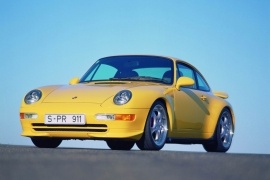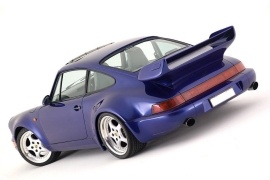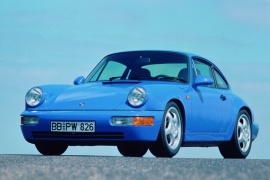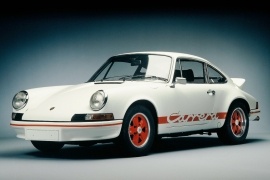PORSCHE 911 Carrera RS Models/Series Timeline, Specifications & Photos
First production year: 1972
Engines: Gasoline
Body style: Coupé (two-door)
The RS version said goodbye to the comfort zone for any Porsche driver. It was track-oriented and it meant business.
For the Porsche 911 – 964 generation, the German car-maker offered a version named RS (Renn Sport – Motor Sport) which was a stripped-down Carrera with stiffer suspension and race engineering. It was the base model for some racing cars. The 993 generation took that inspiration model and returned with an RS version.
From the outside, the wider body, carried-over from the Porsche Turbo, brought a big, fixed, wing in the back. In the front, the bumper was redesigned with an extension of the apron to catch more air and increase the downforce on the front axle, something very needed for the well-known understeered 993 generation. The three-piece light-alloy wheels were specially designed for the RS version.
Inside, the interior was kept to essentials. There were fewer sound-deadening materials in it. The contrast colors on the sport-bucket seats were a standard feature for the RS version. It was available with a stereo, but no air-conditioning or sunroof was offered for this car.
The engine was re-worked. It was based on the 3.6-liter with VarioCam system but enlarged to a 3.8-liter. The result was a massive gain from 285 hp to 330 hp. The Bilstein dampers and the stiffer suspension made the car better around a track. The brakes were bigger than on its sibling and, even though it had less power than the Turbo version, it was faster on a tight race-track.
In 1993 there were not too many car-makers that could offer a race-ready street vehicle. Though, Porsche launched the Carrera RS for those who were heading to the race-track at the weekends.
Based on the regular Porsche 911 – 964 model, the Carrera RS featured the same shape but with different materials. The trunk hood was made out of aluminum. All the sound-deadening materials were removed and the car was stripped down to its essence. A special set of magnesium wheels was installed.
Inside, there was no power-window or power seats. There was no seat in the back either. On some special editions, the car was fitted with a roll-cage and the interior was stripped to the metal. To reinforce the bodywork, the car featured a seam welding technique, that stiffened the bodywork. The only option was a radio and an ashtray.
The air-cooled engine in the back was a 3.6-liter flat-six unit that offered 260 hp. The engine was heavily based on the GT1 racer unit, with a single chain-driven overhead camshaft and only two valves per cylinder and featured a dry-sump lubrication system, which avoids oil starvation issues on extreme G-force conditions. The Carrera RS was fitted with a 5-speed gearbox and a lighter flywheel. To help the exit speed from the corner, a limited-slip differential was fitted as standard.
The 964 Carrera RS was designed for motorsports. It was the lighter version of the Carrera 2 and it offered more performance on the track. It was a car built by enthusiasts for enthusiasts.
By the late '80s and beginning of the '90s, the motorsport rules around the world drastically changed. It wasn't possible anymore to buy a car from a dealer and take it to the track anymore. But Porsche thought that it could offer such a vehicle for the European customers. The U.S. market couldn't get that, since the German carmaker didn't want to get all the homologation forms for the Carrera RS to be approved in the U.S.
The car looked almost the same as a Carrera 2. The magnesium special wheels would tell that there is a different breed and not just another Carrera. Its shape was similar to the rest of the range, but some materials were changed such as the trunk lid, which was made out of aluminum.
The interior was stripped to bare essentials. It featured cranked windows, no carpets, and no sound-deadening materials. The race-bucket seats with holes for a six-point harness and high bolstering were designed for the Carrera RS. There was no power steering, power windows, or sunroof. It wasn't fitted with air conditioning or stereo. Some of these features were available as an option, but most of them were bought like that. It was a car that could have been bought and driven to the race-track the next day.
The engine was a revised 3.6-liter flat-six mated to a 5-speed manual gearbox. Due to its lighter flywheel, it could revs-up quicker. The suspension was lowered and stiffened when compared to the rest of the 964 range. The self-locking differential was fitted as standard.
Porsche started to offer the Carrera RS 2.7 for those who wanted to race the cars in various competitions around the world. It was a stripped-down to essentials race-car with plates.
The 911 was introduced as a concept car at the Frankfurt Motor Show in 1963, as a successor for the 356 model. The production version came in the next year, as a 1965 model. In the beginning, it was offered only as a coupe. Later on, an open-top version, named Targa, was introduced. Soon, the car became famous in the motorsport arena and customers around the world asked for a race-oriented car. In 1972 their wish came to reality and the Carrera RS 2.7 was introduced and 1580 units were built.
The RS was the lighter and more powerful version of the regular 911. It was based on the street-version, but with several improvements. The bodywork was lighter, with an aluminum engine-lid and an integrated spoiler (ducktail). All of the body panels were thinner and lighter: the fenders, the trunk-lid, the roof-panel, the rear quarter panels, and the external door-panels. Even the trims were removed. Moreover, the Porsche badge was a sticker instead of a metallic plaque.
Inside, the car lost the rear seat (emergency seat). The right passenger seat was fixed and there were no sound-deadening materials. To close the doors, Porsche installed leather straps were installed instead of handles. There was no sun-visor for the passenger and, to make the car even lighter, the spare-wheel was removed. Only the battery remained in the trunk.
The standard 2.2-liter engine was enlarged to a 2.7-liter. It was fitted with a Bosch mechanical fuel injected system that raised the power up to 210 hp. It was mated to a standard 5-speed manual gearbox.



